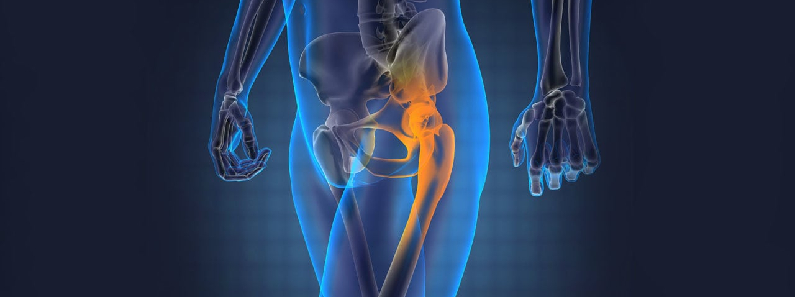
After an injury or surgery, an exercise conditioning program will help you return to daily activities and enjoy a more active, healthy lifestyle. To ensure that the program is safe and effective for you, it should be performed under your doctor's supervision. Talk to your doctor or physical therapist about which exercises will best help you meet your rehabilitation goals.
There are many exercises which will help you meet your rehabilitation goals.
Main Muscles : Tensor fascia
Equipment Needed : None
Repetitions : 2 sets of 10
Days per week : Daily
~ Stand next to a wall for support
~ Cross the leg that is closest to the wall behind your other leg.
~ Lean your hip toward the wall until you feel a stretch at the outside of
your hip. Hold the stretch for 30 seconds.
~ Repeat on the opposite side, then repeat the entire sequence 4 times.
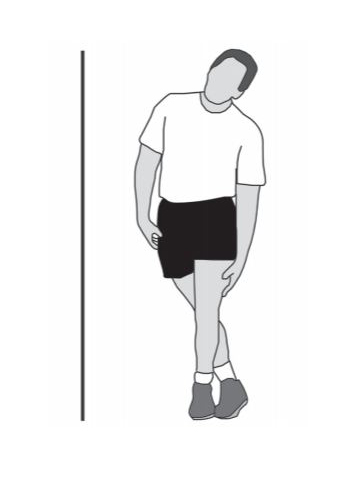
Main Muscles : Piriformis
Equipment Needed : None
Repetitions : 2 sets of 4
Days per week : Daily
~ Sit on the floor with both legs straight in front of you.
Cross one leg over the other.
~ Slowly twist toward your bent leg, putting your hand
behind you for support.
~ Place your opposite arm on your bent thigh and use it to
help you twist further.
~ Look over your shoulder and hold the stretch for 30 seconds. Slowly come back to center.
~ Reverse leg positions and repeat the stretch on the other side. Repeat the entire sequence 4 times.
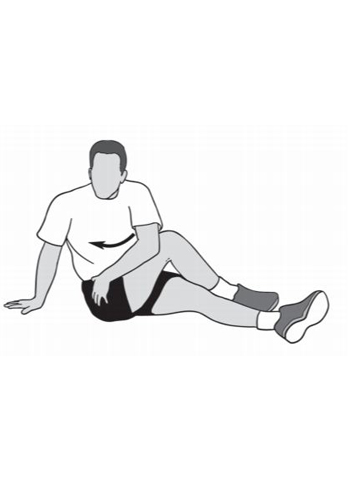
Main Muscles : Gluteus maximus, gluteus medius
Equipment Needed : None
Repetitions : 2 sets of 4
Days per week : Daily
~ Lie on your back on the floor with your legs extended straight out.
~ Bend one knee and grasp your shinbone with your hands.
~ Gently pull your knee toward your chest as far as it will go.
~ Hold the stretch for 30 seconds and then relax for 30 seconds.
~ Repeat on the other side, then pull both legs in together. Repeat the entire sequence 4 times.
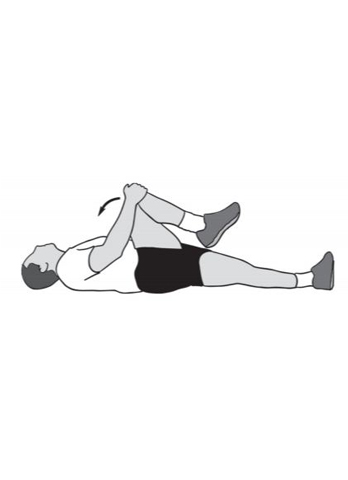
Main Muscles : Hamstrings
Equipment Needed : None
Repetitions : 2 sets of 4
Days per week : Daily
~ Lie on the floor with both knees bent.
~ Lift one leg off of the floor and bring the knee toward your
chest. Clasp your hands behind your thigh below your knee.
~ Straighten your leg and then pull it gently toward your head
until you feel a stretch. (If you have difficulty clasping your
hands behind your leg, loop a towel around your thigh.
Grasp the ends of the towel and pull your leg toward you.)
~ Hold for 30 to 60 seconds and then relax for 30 seconds.
~ Repeat on the other side, then repeat the entire sequence
4 times.
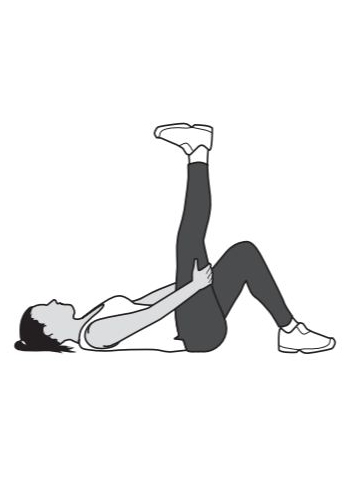
Main Muscles : Gluteus medius, abductors
Equipment Needed : Begin with a weight that allows 8 repetitions and progress to 12 repetitions. As the exercise becomes easier, add weight in 1-pound increments. Each time you increase the weight, start again at 8 repetitions, working back up to 12.
Repetitions : 8
Days per week : 2 to 3
~ Lie on your side with your injured leg on top and the bottom leg bent to provide support.
~ Straighten your top leg and slowly raise it to 45°.
Keep your knee straight, but not locked.
~ Hold this position for 5 seconds.
~ Slowly lower your leg and relax it for 2 seconds.
~ Repeat, then complete exercise on the other side.
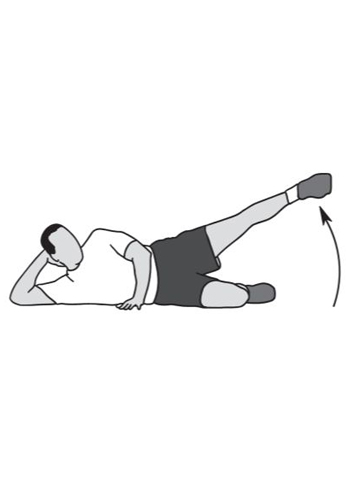
Main Muscles : Gluteus maximus
Equipment Needed : Begin with a weight that allows 8 repetitions and progress to 12 repetitions. As the exercise becomes easier, add weight in 1-pound increments. Each time you increase the weight, start again at 8 repetitions, working back up to 12.
Repetitions : 8
Days per week : 2 to 3
~ Lie on your stomach on a firm, flat surface with a pillow
under your hips.
~ Bend one knee 90°.
~ Lift your leg straight up as shown.
~ Slowly lower your leg down to the floor, counting to 5.
~ Repeat, then complete exercise on the other side.
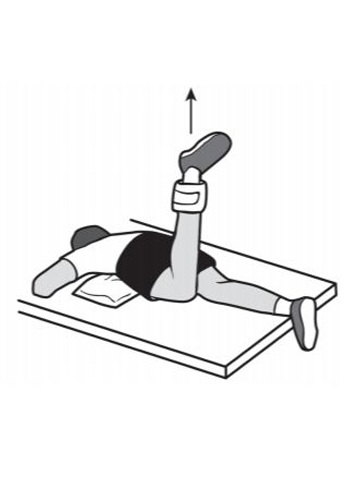
Main Muscles : Medial hamstrings
Equipment Needed : Begin with a weight that allows 8 repetitions and progress to 12 repetitions. As the exercise becomes easier, add weight in 1-pound increments. Each time you increase the weight, start again at 8 repetitions, working back up to 12.
Repetitions : 8
Days per week : 2 to 3
~ Lie on your side on a table or physical therapy bench with a pillow
between your thighs. Place your lower arm in front of your body
and use a pillow under your head for comfort, if needed.
~ Bring your top leg forward and lower your foot so that it is below
the tabletop, as shown in the “start” position. Your bottom leg can
be slightly bent for balance.
~ Rotate your hip and lift your foot as high as possible, as shown in
the “finish” position.
~ Slowly lower your leg back to the “start” position, counting to 5.
~ Repeat, then complete exercise on the other side.
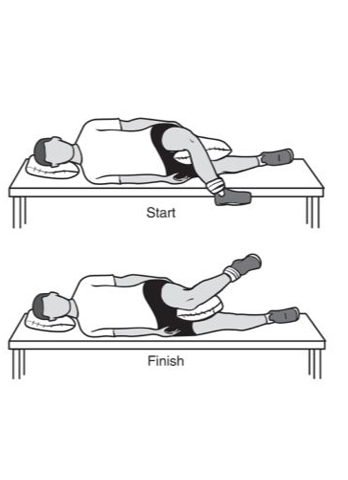
Main Muscles : Piriformis
Equipment Needed : Begin with a weight that allows 8 repetitions and progress to 12 repetitions. As the exercise becomes easier, add weight in 1-pound increments. Each time you increase the weight, start again at 8 repetitions, working back up to 12.
Repetitions : 8
Days per week : 2 to 3
~ Lie on your side on a table or physical therapy bench. Place your
lower arm in front of your body and use a pillow under your head
for comfort, if needed.
~ Bring your bottom leg forward and lower your foot so that it is
below the tabletop, as shown in the “start” position.
Your top leg is mostly straight to help you balance.
~ Rotate your hip and lift your foot as high as possible,
as shown in the “finish” position.
~ Slowly lower your leg back to the “start” position, counting to 5.
~ Repeat on the other side.
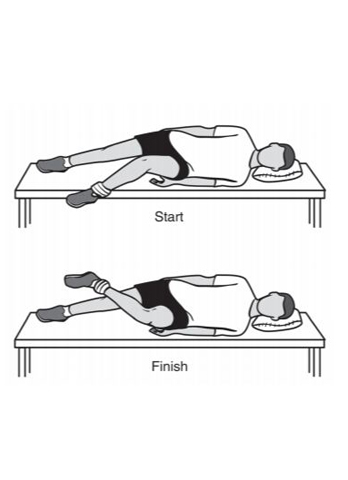
The small puncture wounds take several days to heal. The operative dressing can usually be removed the morning after surgery and adhesive strips can be applied to cover the small healing incisions.
Although the puncture wounds are small and pain in the joint that underwent arthroscopy is minimal, it takes several weeks for the joint to maximally recover. A specific activity and rehabilitation program may be suggested to speed your recover and protect future joint function.